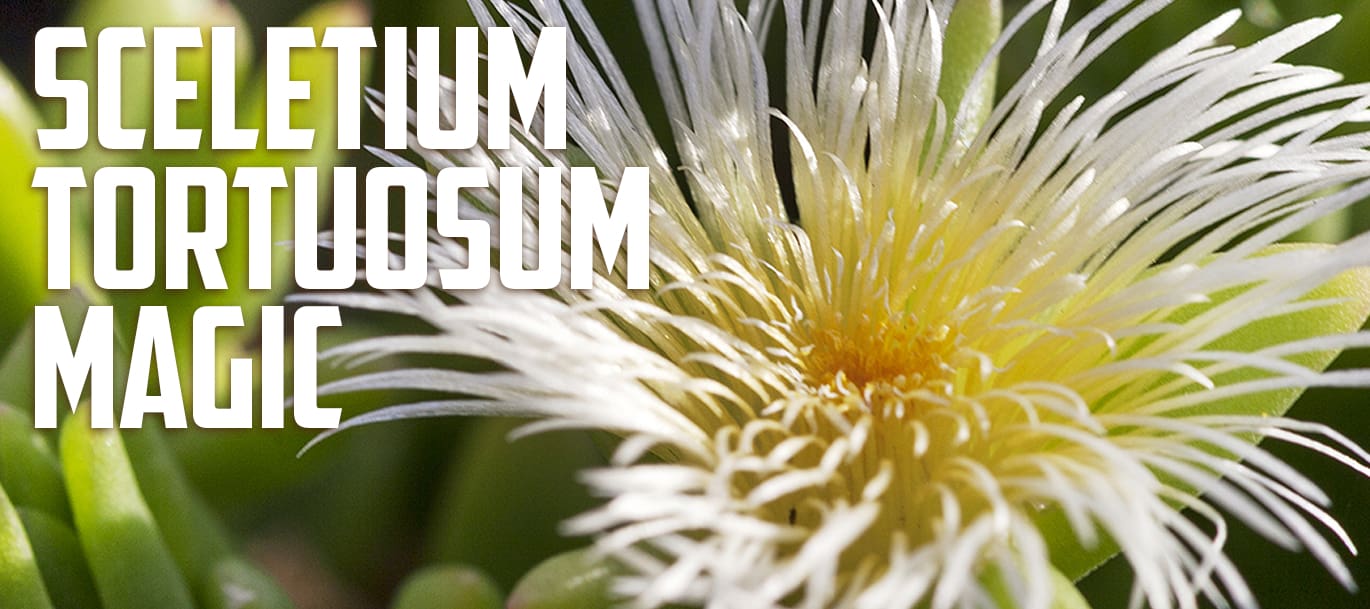Commonly known as Kanna, this African herb is traditionally used by hunter-gatherers for its mood altering properties (Smith et al. 1996) and for coping and reducing state anxiety (Terburg et al. 2013). State anxiety refers to increase in anxiety experienced during a high stress event such as physical exercise or a test.
Sceletium tortuosum contains the major alkaloids mesembrine and mesembrenone, and lesser mesembrenol and mesembranol (Roscher et al. 2012). Mesembrine has an affinity towards the serotonin transporter (Harvey et al. 2011).
The brain is made up of countless neurons that transmit signals called nerve impulses. When a nerve impulse reaches the end of the neuron, it encounters the synapse, a kind of “gap”. The nerve impulse cannot pass directly to the next neuron due to the synapse (Feher 2012).
To jump the synapse, the nerve impulse triggers the neuron to release a chemical neurotransmitter, such as serotonin. The neurotransmitter drifts across the synapse between the two neurons, forming a bridge and allowing the nerve impulse to transfer across (Alberts et al. 2002).
Neurons have many points on their surface, each with a known receptor and affected by a particular neurotransmitter. When enough of the neurotransmitters are received by their relevant receptor, a nerve impulse is started and the signal continues to its final destination (Nicholls et al. 1992).
To allow neurons to receive new messages, the brain takes away the neurotransmitter that is bridging the synapse from the neuron receptors. This also permits the signal to be sent back to the originating nerves, a process known as re-uptake (Douglas Fields 2008).
Depression is caused by low levels of the neurotransmitter serotonin. Sceletium tortuosum’s mesembrine acts as a serotonin reuptake inhibitor, delaying the re-uptake process of serotonin, increasing the probability of there being enough serotonin in the relevant receptors. This significantly increases the chance of signal transfer in all neighbouring neurons (Bennett et al. 2016).
Mesembrine also acts as a weak phosphodiesterase 4 (PDE4) enzyme inhibitor. PDE4 is the main enzyme Involved in modulating inflammation. In inhibiting PDE4, mesembrine can help lower inflammation, improve insulin resistance, enhance thermogenesis (Wu et al. 2015), and improve lung airflow limitations (Beghè et al. 2013).
The PDE4 family of enzymes are the most common PDE in immune cells, and are predominantly responsible for is the breakdown of the second messenger cAMP within immune cells and cells in the central nervous system (Spina 2008).
cAMP is a signaling molecule used for advanced intracellular mediation in many different many physiological processes, in particular transferring into cells the effects of the hormones glucagon and adrenaline. These hormones cannot pass through the cell membrane, so they need cAMP as a second messenger to activate protein kinase A (PKA) (Stanley McKnight 1991).
The presence of adrenaline and glucagon elevates cAMP levels (Berg et al. 2002), which then binds to the otherwise inactive PKA, making it active. PKA then phosphorylates glycogen phosphorylase b (GPb), transforming it into the active glycogen phosphorylase a (GPa).
Phosphorylation of phosphorylase kinase activates the enzyme (Johnson 1992). The end result is that you stimulate glycolysis which creates ATP for muscle contraction (Baker et al. 2010). cAMP also regulates the passage of metal ions like calcium, through ion channels, another important factor for muscle contraction (Szent-Györgyi 1975).
An extract from the book 'Creating The Anomaly'.
After a product that uses sceletium tortuosum? Try Chemix Pre-Workout.

